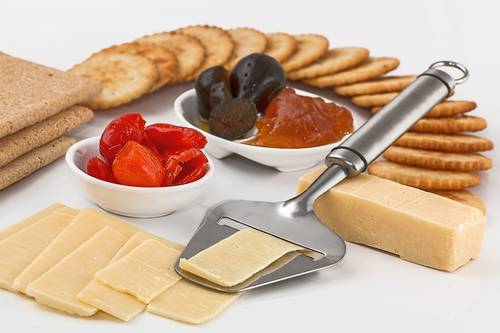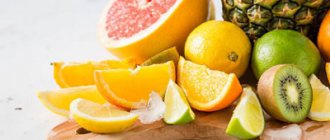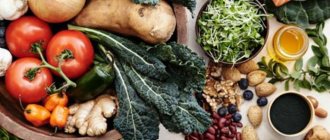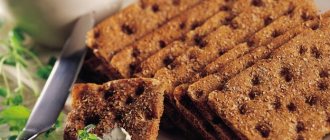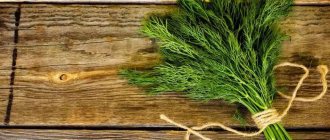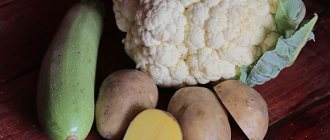Hello readers of my blog. Today I want to continue the topic of proper nutrition, started in this article.
I have also already talked about the components of proper nutrition and the importance of balancing them.
Here, I want to talk about another fact that needs to be taken into account when compiling our daily menu - the compatibility of products for proper nutrition.
Eating compatible foods will help our body fully absorb the nutrients of a particular product.
How does this happen?
All food products have a different chemical composition, which of course affects their “digestibility” in our body: • this is the time that needs to be spent on digesting a certain group of products; • these are certain enzymes that process this food.
Let me explain this in a little more detail.
There are foods that are quickly digested, and there are foods that are slowly digested. If we consume them together, then food, which should quickly leave our body, will linger longer, the digestion process is disrupted - the food is not digested, but simply rots or ferments!
For example, an apple eaten at work (as a snack) leaves the stomach within half an hour. If we “snack” an apple after potatoes and meat (it takes more than 4 hours to digest), then it remains with these “slow” products and after 30 minutes it is already completely fermented.
In addition, a particular product in the stomach requires a different environment. So meat needs an acidic environment, and potatoes are “processed” into an alkaline environment.
The large intestine is also involved in all this. In it, food is no longer “processed” by our enzymes, but by our microorganisms - bacteria.
Let's roughly divide them into good and bad.
The good ones increase our immunity, help us “absorb” vitamins, process fiber, fight bad bacteria, etc.
Bad ones are all sorts of pathogenic microorganisms that are always present in our body. But some even help - they fight our “wrong” food, help quickly process it and remove it from the body.
So - raw plant food is processed by our well-wishers - beneficial bacteria, and the more and longer we consume such food, the more of them and the stronger our immunity becomes. And when we mix food - meat with salad, then a war begins in the intestines (and the consequences are gases) of who will win.
Therefore, it is very important for us to know how to properly combine foods with proper nutrition so that digestion time, enzymes, etc. more or less coincided, and there will be no imbalance in the process of their processing, because this is the basis of a healthy lifestyle .
Of course, we don’t know what we process with what, and what is combined with what.
But there was a doctor, Herbert Shelton, who offered us his table of food compatibility for proper nutrition.
There are controversial points in this table that modern scientists criticize (we know how they feel about everything that contradicts their dogmas). Of course, we cannot determine the correctness of all combinations of products, so whether to believe or not is up to you.
And further. You can always check with your body, and it will always tell you whether you have chosen the right combination or not.
How to Use a Food Combination Chart
The highlighted color means: Green cell – compatible products. Yellow - can be combined. Red – incompatible products.
For example, let’s look at how butter and bread combine. Butter - No. 3, bread - No. 7. We look at the intersection of No. 3 with No. 7 - we see green, ideal. That is, these are compatible products.
Incompatibility and compatibility of products, separate nutrition according to Shelton (Table)
The essence of food compatibility is that ideally a person should eat 1 food item at a time. This way, all nutrients will be absorbed to the maximum extent possible.
Compatibility and incompatibility of products, separate nutrition according to Shelton
According to Shelton's separate nutrition method, naturopaths classified food products and divided them into groups:
| Squirrels | meat, fish, eggs, cheese, cottage cheese, nuts, mushrooms, beans, legumes, dry peas, eggplant, milk, sunflower seeds |
| Carbohydrates | potatoes, cereals, dried beans, pumpkin, zucchini, beets, carrots, cauliflower, sweet fruits - raisins, dried apricots, figs, persimmons, dates, dried pears and sweet apples |
| Fats | all types of vegetable oils, nuts, lard, fatty meat, sour cream, cream |
| Green vegetables | lettuce, celery, onion, spinach, sorrel, dill, parsley, cucumbers, cabbage, garlic, rhubarb, sweet peppers of all colors, all kinds are rare, etc. |
| Fruits | sour (including tomatoes), semi-sweet |
Green vegetables are compatible with the previous three groups. All of these groups, with the exception of green vegetables, are incompatible with each other. And in the groups themselves you cannot mix products. As you can see, low-fat lettuce is a desirable ingredient in all dishes. Bread and butter also go together.
Change your diet gradually, taking into account food compatibility and Shelton's principles of food division.
Using this classification, you can choose your daily diet so that the foods are not only compatible, but also match the proportion of acidic and alkaline foods, which should be about half.
As you gradually change your diet, increase your consumption of raw foods, as they provide the energy the body needs and cannot get from another source.
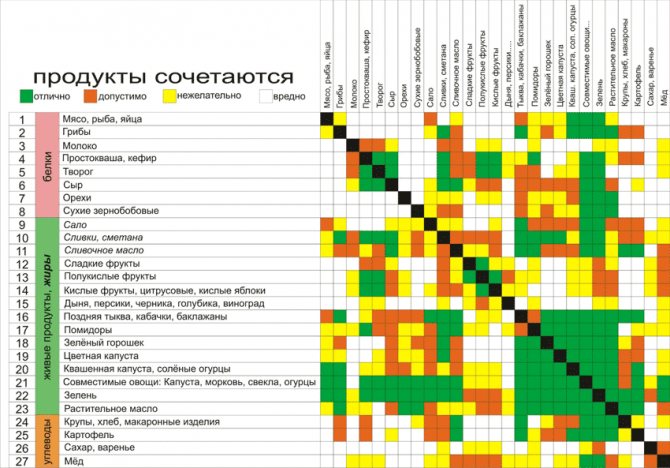
Table of compatibility and incompatibility of products according to Shelton
| Food | Compatible with products: | Incompatible with products: |
| Lean meat, lean fish, lean poultry | • Green vegetables; • Vegetables that do not contain starch | • Pulses; • butter, cream; • sour cream; • vegetable oil; • sugar, condit. products; • bread, cereals, potatoes; • all types of sour fruits, tomatoes; • all types of sweet fruits, dried fruits; • milk; • cottage cheese, fermented milk. products; • cheese, feta cheese; • eggs; • nuts |
| Pulses | • Sour cream, grows. oil; • Vegetables that do not contain starch (except for potatoes); • vegetables that are green and do not contain starch | • lean meat and fish, lean poultry; • sugar, condit. products; • all types of sour fruits, tomatoes; • all types of sweet fruits, dried fruits; • milk; • cottage cheese, fermented milk. products; • cheese, feta cheese; • eggs; |
| Drain oil, cream | • Bread, cereals, potatoes; • sour fruits, tomatoes; • starchy vegetables; • green and non-starchy vegetables | • lean meat, lean fish, lean poultry; • vegetable oil; • sugar, confectionery; • all types of sweet fruits, dried fruits; • cottage cheese, fermented milk products; • eggs; • nuts |
| Sour cream | • Grain legumes; • bread, cereals, potatoes; • sour fruits, tomatoes; • starchy vegetables; • green and non-starchy vegetables; • cottage cheese, • fermented milk products | • lean meat, lean fish, lean poultry; • sugar, confectionery; • milk; • nuts |
| Vegetable oil | • Grain legumes; • bread, cereals, potatoes; • sour fruits, tomatoes; • starchy vegetables; • green vegetables, non-starchy vegetables; • nuts | • lean meat, fish, poultry; • drained oil, cream; • sugar, confectionery; • milk; • cottage cheese, fermented milk products; • cheese, feta cheese; • eggs |
| Sugar, condit. products | • Green vegetables, non-starchy vegetables | • Meat, fish, lean poultry; • grain legumes; • drained oil, cream; • sour cream; • vegetable oil; • bread, cereals, potatoes; • all types of sour fruits, tomatoes; • all types of sweet fruits, dried fruits; • starchy vegetables; • milk; • cottage cheese, fermented milk products; • cheese, feta cheese; • eggs; • nuts |
| Different types of bread, cereals, potatoes | • Butter; • cream; • sour cream; • vegetable oil; • starchy vegetables; • green vegetables, non-starchy vegetables; | • Meat, fish, lean poultry; • sugar, confectionery products; • all types of sour fruits, tomatoes; • all types of sweet fruits, dried fruits; • milk; • cottage cheese, fermented milk products; • eggs |
| All types of sour fruits, tomatoes | • Butter and cream; • sour cream; • vegetable oil; • green vegetables, non-starchy vegetables; • cheese, feta cheese; • nuts; | • Meat, fish, lean poultry; • grain legumes; • sugar, confectionery products; • bread, cereals, potatoes; • milk; • eggs |
| All types of sweet fruits, dried fruits | • Green vegetables, non-starchy vegetables; • cottage cheese, fermented milk products. | • Meat, fish, lean poultry; • grain legumes; • drained oil, cream; • sugar, confectionery products; • bread, cereals, potatoes; • cheese, feta cheese; • eggs |
| Green vegetables, non-starchy vegetables | • Lean meat, lean fish, lean poultry; • grain legumes; • butter and cream; • sour cream; • vegetable oil; • sugars, confectionery products; • sour fruits, tomatoes; • bread, cereals, potatoes; • sweet fruits, dried fruits; • starchy vegetables; • cheese, feta cheese; • cottage cheese, fermented milk products; • eggs; • nuts; | • Milk |
| Starchy vegetables (except potatoes) | • Grain legumes; • butter and cream; • sour cream; • vegetable oil; • bread, cereals, potatoes; • green and non-starchy vegetables; • cottage cheese, • fermented milk products; • cheese, feta cheese; • nuts; | • Sugar, confectionery products |
| Milk | • Meat, fish, lean poultry; • grain legumes; • sour cream; • vegetable oil; • sugar, confectionery products; • bread, cereals, potatoes; • all types of sour fruits, tomatoes; • green vegetables, non-starchy vegetables; • cottage cheese, fermented milk products; • cheese, feta cheese; • eggs; • nuts | |
| Cottage cheese, all types of fermented milk products | • Sour cream; • sweet fruits, dried fruits; • starchy vegetables (except potatoes); • green vegetables, non-starchy vegetables; • cheese, feta cheese; • nuts | • Meat, fish, lean poultry; • grain legumes; • drained oil, cream; • vegetable oil; • sugar, confectionery products; • bread, cereals, potatoes; • milk; • eggs |
| Cheese, feta cheese | • Sour fruits, tomatoes; • starchy vegetables (except potatoes); • green vegetables, non-starchy vegetables; • cottage cheese, fermented milk products. | • Meat, fish, lean poultry; • grain legumes; • vegetable oil; • sugar, confectionery products; • all types of sweet fruits, dried fruits; • milk; • eggs |
| Eggs | Compatible with green and non-starchy vegetables | • Meat, fish, lean poultry; • grain legumes; • drained oil, cream; • vegetable oil • sugar, confectionery products; • bread, cereals, potatoes; • all types of sour fruits, tomatoes; • all types of sweet fruits, dried fruits; • milk; • cottage cheese, fermented milk products; • cheese, feta cheese; • nuts |
| Nuts | • Vegetable oil; • sour fruits, tomatoes; • starchy vegetables (except potatoes); • green and non-starchy vegetables; • cottage cheese, all types of fermented milk products. | • Meat, fish, lean poultry; • drained oil, cream; • sour cream; • sugar, confectionery products; • milk; • eggs |
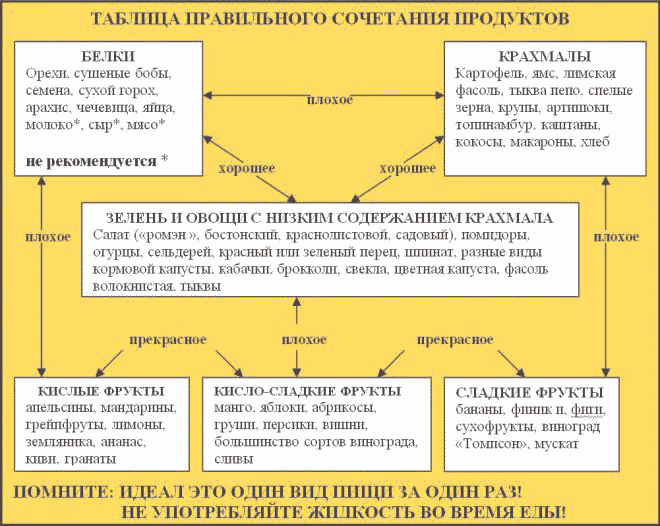
Table of product incompatibility and harm to the body
This table lists products whose combinations in one form or another can lead to negative consequences for the body.
| Incompatible products | Harm to the body, side effects |
| SEAFOOD + TOMATOES | Causes nausea, intestinal upset, and the properties of protein are leveled. |
| CUCUMBERS + TOMATOES, HOT PEPPERS | Destroys vitamin C |
| BEEF + CHESTNUT | Impairs digestion |
| WHITE RADISH + APPLE, MANDARNINE, TOMATO, GRAPES | Causes a sore throat |
| BEEF WITH YOUNG GARLIC | Poison for the whole body! |
| CARROTS + WHITE RADISH | Causes blood cancer |
| LAMB + TEA | Impairs digestion |
| SODA DRINKS + SPICY FOODS | Causes diseases of the gastrointestinal tract (GIT) |
| BEEF + FISH | Poison for the liver and kidneys. They don't fit in any way! |
| ONION + GARLIC | Causes intestinal cramps and impairs digestion. |
| CARROTS + VODKA | Causes severe liver poisoning |
| CORN + BUCKWHEAT | It provokes skin diseases, worsens metabolism, and concentration decreases. |
| PRAWNS + PEPPER, TOMATO | Poison for the whole body! |
| SOY MILK + EGG | The properties of protein are leveled, and the digestibility of products deteriorates. |
| BEER + SAUSAGES or GRILLED SAUSAGES | Causes cancer! |
| RABBIT + CELERY | Causes hair loss and dullness. From the gastrointestinal tract - diarrhea. |
| LIVER + CAULIFLOWER | Poison for the whole body! |
| TEA + EGG, TOFU CHEESE | Impairs digestion. |
| FISH + PICKLES | Poison for the whole body! Causes cancer! |
| MEAT + TEA | It neutralizes the properties of protein and is harmful to the intestines. |
| RABBIT + DUCK | Causes diarrhea, chills, weakness in the body. |
| LAMB WITH GINGER | Causes dry mouth, sore throat, kidney pain. |
| HONEY WITH GARLIC AND ONION | Impairs vision! |
| GREEN BEANS + HONEY | When consuming foods in this combination, vitamin B1 is destroyed. |
| VODKA + PEACH | In any form, from compote to the fruit itself, it causes dizziness, nausea, and arrhythmia. |
| VODKA + TOMATO | In any form, including with tomato juice, it causes kidney stones, pulmonary diseases, oxygen starvation... |
| BANANA + MELONS | Provokes kidney failure and joint diseases. |
| CHICKEN + SESAME, CHAMOMILE TEA | Poison for the whole body! |
| SOY MILK + HONEY | Causes diarrhea, tinnitus. |
| VINEGAR + CARROTS | Makes carrots useless for the body, all vitamins disappear. |
| CHICKEN + CELERY, MUSTARD | Reduces energy activity, this combination is dangerous for the kidneys. It also reduces potency and negatively affects sperm. |
| PORK WITH PEAS | Causes bloating and increased gas formation. |
| CRAB + PEANUTS | Impairs intestinal motility and causes indigestion. |
| RADISH + BLACK MUSHROOMS | Causes skin allergies. |
| MILK + CHOCOLATE | Causes dry hair and impairs digestion. |
| BANANA + POTATOES | This combination is extremely harmful to the skin, blackheads may appear... |
| VODKA + SODA DRINKS | A terrible blow to the stomach, liver and kidneys at the same time! This combination provokes cardiovascular diseases. |
| MONSOLUM GLUTAMATE + EGG | In any combination, a terrible poison for the entire body, leading to death! |
| VODKA + COFFEE | Impairs cerebral circulation. |
| TOFU CHEESE + SPINACH | Digestion worsens, and bloating often occurs. |
| BEER + MEAT SOUP | Very harmful to joints, kidneys and gallbladder. |
| YOUNG GARLIC + VODKA | Provokes gastrointestinal diseases, hemorrhoids, bleeding. |
| BEER + SHELLS | Provokes cancer, kidney stones and gall bladder. |
| VODKA + TEA | Completely incompatible drinks provoke heart and kidney diseases. |
| LAMB + PUMPKIN, WATERMELON | Reduces energy activity, negatively affects sperm and the body’s lymphatic system |
| MILK + POMEGRANATE, GRAPES, ROSE HIP | Causes nausea, dizziness, bloating, and intestinal upset. |
| CUCUMBERS + PEANUTS | This combination is extremely bad for the kidneys. Causes diarrhea. |
| BEER + VODKA | A terrible blow to the liver, kidneys and heart |
Explanation of some products from the table
No. 8. Tomatoes and sour fruits These are tomatoes and fruits that have acid - currants, strawberries, pineapples, pomegranates, strawberries, limes, tangerines, grapefruits and oranges.
No. 9. Semi-acidic fruits These include - quince, grapes, gooseberries and raspberries, blackberries, blueberries, cherries, gooseberries, nectarines and peaches, pears and apples, plums and apricots
No. 10. Sweet fruits These are figs, bananas, dried fruits, mangoes, persimmons, etc.
No. 11. Non-starchy vegetables Brussels cabbage, white cabbage and cauliflower, broccoli, parsnips, celery, sorrel, cucumbers, eggplant, lettuce, peppers (sweet), rutabaga. Sprouts: wheat, barley, alfalfa, etc.
No. 12. Starchy vegetables Artichoke, beans, carrots, corn, peanuts* Jerusalem artichoke, peas, potatoes, pumpkin. * Peanuts, lentils, legumes and all grains combine both protein and starch.
Basic provisions
The separate nutrition system became famous thanks to the American naturopath Herbert Shelton and, to a lesser extent, the surgeon William Howard Hay. Hollywood stars, many of whom were also his patients, played a major role in the dissemination and popularization of Shelton’s system.
In 1928, G. Shelton published the book “The Correct Combination of Food Products,” in which he proposed a number of recommendations that are common to all people. The main postulate of Shelton's separate nutrition system is that the conditions necessary for the digestion of different types of foods are radically different. Ideologists of separate nutrition stated that when food of one type is supplied, the enzymes that break it down work most efficiently, which facilitates the process of digestion and further metabolism of nutrients. It is argued that when eating traditional mixed food, the activity of digestive enzymes is allegedly inhibited and the digestion processes are disrupted, which causes fermentation or rotting of food, intoxication of the body, increased gas formation, and metabolic disorders. Thus, according to Shelton's hypothesis, when eating properly, certain combinations of foods should be avoided. An extreme manifestation of the idea of separate nutrition is a monotrophic raw food diet.
Product Compatibility Chart
In addition to the digestion time, it is also necessary to take into account the energy value of foods - food in which carbohydrates predominate does not go well with fats. The same applies to proteins. To make it easier to determine the combination of products, a special table was created by which it can be determined. It shows which ingredients we combine this or that component with and which we don’t.
| Products | Fine | Badly |
| Non-acidic fruits | Fermented milk products | Sour fruits, cereals, baked goods, dairy products |
| Sour fruits | Milk, nuts | Starchy foods, cereals, baked goods, sweets, protein foods |
| Starchy | Vegetables, oils | Protein, fruit, sugar |
| Meat | Vegetables | Milk, sweet, sour vegetables, oils, fruits |
| Eggs | ||
| Nuts | Vegetables, sour fruits | |
| Milk products | Non-acidic fruits | Vegetables, cereals, legumes |
| Cereals | Vegetables | Sour fruits, sweet, dairy products |
Potatoes + tomatoes
Tomatoes should not be eaten with any starchy food. The combination of citric, malic and oxalic acids is contraindicated in the alkaline digestion of starches in the mouth and stomach. In this case, the acid found in tomatoes prevents the body from absorbing beneficial substances from potatoes, and starch will deprive the tomatoes of their beneficial qualities and the vegetables will fall as a useless burden into the stomach. But this is one of the popular combinations - potatoes with tomato salad or French fries with ketchup.
Tomatoes are best eaten with leafy salads and fats.
Product incompatibility table
To make life easier for those who want to lose weight or who preach the benefits of separate meals, a table has been developed to help quickly navigate the choice of healthy food. With its help, you can figure out which foods should not be eaten together. The table is a grid, at the intersection of the vertical and horizontal columns of which there is a compatibility mark. Wherein:
- in the first column from top to bottom the products are listed by number;
- the top line contains numbers corresponding to the food order from the first column.
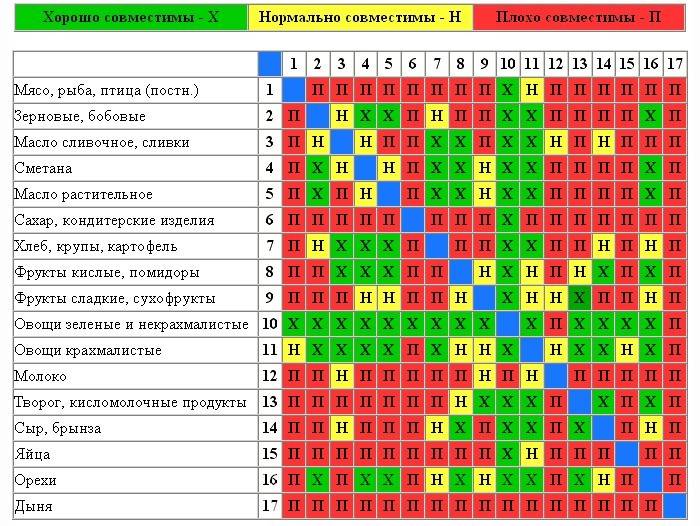
- How to make your hair smooth
- How to prepare lean and choux pastry for dumplings with potatoes
- Pain in the left hypochondrium
Shelton compatibility table
The American scientist Herbert Shelton, who wrote many books on weight loss and fasting, dealt seriously with the issue of separate nutrition. Thanks to his research and propaganda, the system of combining incompatible products became widespread. Shelton has developed a table with which you can easily figure out what you need to eat with what. This promotes stomach function and the ability to stay healthy.
Shelton's table in the intersection of graphs helps to find out the compatibility of the main types of food used by humans. By examining the material, you can understand that melon cannot be combined with anything. It is recommended, for example, to use together:
- meat – non-starchy vegetables – eggplant, cucumber, sweet pepper;
- potatoes, bread – vegetable oil;
- grains – all vegetables;
- sweet fruits – fermented milk products, cottage cheese;
- starchy vegetables - cauliflower, pumpkin, carrots - everything except sugar.
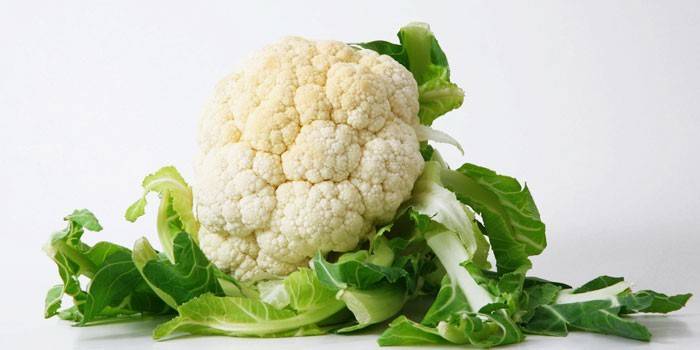
What products cannot be combined?
Regular meals and the right combination of foods means no digestive problems, good health, and a toned figure. Do you know what products can be combined with each other to avoid unpleasant sensations in the stomach - bloating, rumbling (sometimes putting you in an awkward position in front of others), problems with stool (sorry, but this topic cannot be avoided). And heartburn, which can torment for hours? This article is intended for those who read these lines and recognize themselves. However, it will be useful not only for those who have digestive problems, but also for those who simply want to eat right.
Let's start with products that are undesirable or better not to be combined with each other.
1. CUCUMBERS AND TOMATOES.
Not all nutritionists agree with this statement. But it is difficult to deny the fact that to digest cucumbers, the stomach requires more hydrochloric acid than to digest tomatoes, which begin to ferment due to excess acid. And if you have chronic gastritis in the acute stage, then, of course, this will not help reduce inflammation in the stomach. In addition, cucumbers contain an enzyme that neutralizes vitamin C, which tomatoes are rich in (12.7 mg per 100 g).
2. FRUIT
It is not recommended to consume after meals, because the so-called “simple sugars” they contain are quickly absorbed by the body, and foods rich in proteins, fats and starch (for example, meat and pasta) will slow down the process of their digestion. And this will lead to bloating and rumbling in the stomach. If you want to eat a pear or banana, do it 30-40 minutes before meals. By the way, pear is a leader in dietary fiber content and an excellent digestive stimulant. I would also like to say something about melon! Melon should be eaten separately from all other foods or not eaten at all.
3. LASAGNA
(or any other combination of pasta and meat, it all depends on the imagination of the cook). Proteins and starch... A difficult combination! To digest these foods, different enzymes and different levels of acidity are needed. Your stomach will be forced to digest proteins, while starchy foods will sit like stones, causing some discomfort. The same applies to cheese sandwiches! Add some greens (such as arugula) to the cheeses and they will become more pleasant to the stomach. To this point I would like to add one more incorrect, but so familiar to us, combination - potatoes with meat - and all for the same reason.
4. A few more words about SANDWICH WITH CHEESE AND COFFEE.
Favorite food combination for breakfast: tasty and quick. Do you already know that proteins + starch = digestive discomfort. Yes, there is no particular harm from the combination of these products, but coffee interferes with the absorption of B vitamins, which are contained in bread (especially rye).
5.OMELET WITH CHEESE OR MEAT
(depending on your taste preferences - with sausages, sausage or bacon) - even I won’t argue that it’s delicious... But 2 types of protein in one meal is too much. As expected, fish and egg are not the best combination. The stomach will have to work hard to digest and assimilate your gastronomic happiness! The ideal companion for an omelet or scrambled eggs is vegetables: tomatoes, broccoli, spinach, onions.
6. OATTLE PORridge WITH MILK + ORANGE JUICE.
The acids in which the juice is rich destroy the enzyme necessary for the digestion of starch (in cereals the content of this component ranges from 54 to 78%, depending on the type of cereal, in oatmeal - 61%!). And the combination of juice and milk is not the healthiest. This also includes cottage cheese (especially low-fat) + jam or preserves. By the way, calcium from low-fat cottage cheese is almost not absorbed, so it’s worth thinking about the benefits of this product.
7. About ALCOHOL, WINE AND DESSERTS
. I will not now urge you not to drink alcohol. But you must understand that there are no safe doses of alcohol (although the WHO allows consumption of these drinks in quantities not exceeding 21 drinks for men and 14 drinks for women per week, but this is a separate and complex topic). Wine stimulates the production of insulin, which, in turn, promotes the accelerated absorption of sugars, and this increases the amount of fat deposits. The optimal complement to wine would be light cheese and fresh vegetables. But evening alcohol and morning coffee would not be the most successful combination: the body is dehydrated and instead of vigor, you will get a rapid heartbeat.
Of course, people who do not have digestive problems rarely face the consequences of an incorrect combination of foods. But if you constantly test your digestive tract for strength, sooner or later it may fail!
Not everything is as sad as you might think. Next time I will talk about which products are ideally combined with each other and there can be a great many options.
Take care of yourself and your loved ones and be healthy!
The article was prepared by a gastroenterologist, nutritionist - Elena Sergeevna Sukharevskaya
Principles of combining products from Maya Gogulan
Maya Gogulan is a famous journalist and supporter of the principle of separate nutrition. Her system is a combination of products based on nutritional components. The main rules of the combination look like this:
- carbohydrates should not be consumed simultaneously with carbohydrates (for example, eat porridge and pasta with bread);
- eat proteins at one meal with carbohydrates (for example, do not eat fish as a snack with bread, but oatmeal with chicken);
- vegetables can be combined with each other and with any other products;
- Vegetable and animal fats are well complemented by carbohydrates or protein.
In addition, Gogulan advises completely eliminating sugar from the diet, reducing the amount of salt and spices, which lead to increased appetite. Make the choice of products towards unprocessed ones. Oatmeal is a good example—coarse, unrefined flakes are better than processed ones. It is necessary to leave the table slightly undernourished. There must be a desire to do something. Drowsiness and laziness are signs that a person has overeaten, and this is not beneficial.
Many experts also advise paying attention to the method of preparing dishes - reducing the consumption of fried foods, replacing boiled
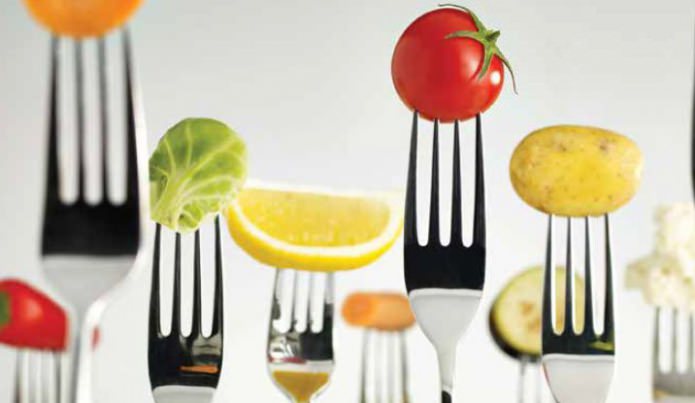
Oatmeal with milk and citrus fruits

As we have already found out, it is better to eat fruits separately. But many adherents of a healthy diet, trying to diversify their daily diet, add citrus fruits: oranges, tangerines, grapefruit to oatmeal cooked in milk. Vitamin C destroys enzymes that help digest starchy foods. In addition, the increased acidity of citrus fruits turns milk into curds, which leads to bloating and gas formation.
It is important to understand which foods cannot be combined with each other so that the food is as healthy as possible and does not cause unpleasant consequences. Using incompatible products does not mean that the dish will be tasteless. It will likely be less useful.
3 dinners for two with free delivery for RUB 1,990.
View menu
Meat + fruit
This is also a traditional combination in Arab countries. For example, delicious meat stewed with prunes in tagine. And it doesn't fit either.
Quince, prunes and pineapple are not compatible with meat; they inevitably lead to abdominal discomfort. Sweet carbohydrate foods are not compatible with protein foods.
It is better to eat fruits at least 15 minutes before meals or 2 - 3 hours after meals, and better in the first half of the day. Therefore, you should not eat fruit for dessert. Hot foods take much longer to digest than fruits, which begin to ferment in the stomach after 15 minutes.
Not all combinations are useful
Our diet includes dishes of various compositions. Food of animal origin mostly consists of proteins and fats. Plant ingredients can contain a high percentage of carbohydrates (like sugar or bananas), starch (potatoes), fiber (cabbage, carrots). Trying to create a balanced menu, we often eat several foods at one meal, the combination of which is harmful to the stomach, although individually each of them is healthy.
All foods require different amounts of time to be processed and absorbed by the body. For example, meat takes much longer to digest than fruit. Mixing in the stomach, such food is considered unprocessed for a long time. As a result, food debris accumulates in the intestines, which form waste.
Digestive problems immediately affect our skin. She does not have time to remove toxins from the body and becomes covered in acne.
Principle of classification
Nutritionist Howard Hay identified three food groups:
- protein (with a protein content of more than 20%) - meat, eggs, whole milk, fish, soy, tofu;
- carbohydrates - potatoes, bread, pastries, pasta, sweet fruits (bananas, dried fruits, dates, figs), sugar, rice;
- neutral - fermented milk products, cheeses with a fat content of more than 40%, feta cheese, vegetables, and other fruits.
To digest protein foods, a larger amount of gastric juice is required, so you should not mix them with carbohydrate foods. Ingredients included in different groups go well only with neutral types of food.
Not all foods are compatible with each other, since the stomach produces different enzymes to digest them. For example, it is better not to combine meat with cheese, nuts or fermented milk drink. Animal and vegetable fats are also poorly digested together.
If you like milk, drink it in small quantities and separately from other meals. This is a very complex product that takes a long time to digest and slows down the absorption of any other dishes.
